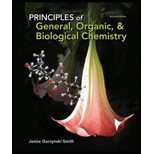
Principles of General Organic & Biological Chemistry
2nd Edition
ISBN: 9780077633721
Author: Janice Smith
Publisher: Mcgraw-hill Higher Education (us)
expand_more
expand_more
format_list_bulleted
Question
Chapter 4.4, Problem 4.13P
Interpretation Introduction
Interpretation:
At room temperature
Expert Solution & Answer
Want to see the full answer?
Check out a sample textbook solution
Students have asked these similar questions
Give an example of Interhalogen Compounds?
Explain why the interhalogen molecule BrCl3 exists but ClBr3 does not.
Explain why CO 2 is a gas at room temperature but H 2O is a liquid
Chapter 4 Solutions
Principles of General Organic & Biological Chemistry
Ch. 4.1 - Prob. 4.1PCh. 4.1 - Prob. 4.2PCh. 4.1 - Prob. 4.3PCh. 4.1 - Prob. 4.4PCh. 4.2 - Prob. 4.5PCh. 4.2 - Prob. 4.6PCh. 4.3 - Prob. 4.7PCh. 4.3 - Prob. 4.8PCh. 4.3 - Prob. 4.9PCh. 4.3 - Prob. 4.10P
Ch. 4.3 - Which of the compounds in each pair has stronger...Ch. 4.4 - Prob. 4.12PCh. 4.4 - Prob. 4.13PCh. 4.5 - A student has two containers one with 10 g of...Ch. 4.5 - Prob. 4.15PCh. 4.5 - How much energy is required to heat 28.0 g of iron...Ch. 4.5 - Prob. 4.17PCh. 4.5 - Prob. 4.18PCh. 4.5 - Prob. 4.19PCh. 4.6 - Prob. 4.20PCh. 4.6 - Prob. 4.21PCh. 4.6 - Label each process as endothermic or exothermic...Ch. 4.6 - Prob. 4.23PCh. 4.7 - Answer the following questions about the graph. a....Ch. 4.7 - Prob. 4.25PCh. 4.7 - If the cooling curve in Figure 4.5 represented a...Ch. 4.7 - How much energy (in calories) is released when...Ch. 4.7 - Prob. 4.28PCh. 4 - What phase change is shown in the accompanying...Ch. 4 - What phase change is shown in the accompanying...Ch. 4 - Consider the cooling curve drawn below. a. Which...Ch. 4 - Which line segments on the cooling curve in...Ch. 4 - Prob. 4.33UKCCh. 4 - Prob. 4.34UKCCh. 4 - Prob. 4.35UKCCh. 4 - Prob. 4.36UKCCh. 4 - Prob. 4.37UKCCh. 4 - Prob. 4.38UKCCh. 4 - Prob. 4.39APCh. 4 - Prob. 4.40APCh. 4 - Prob. 4.41APCh. 4 - Prob. 4.49APCh. 4 - Prob. 4.50APCh. 4 - Prob. 4.54APCh. 4 - Prob. 4.55APCh. 4 - Prob. 4.56APCh. 4 - Prob. 4.57APCh. 4 - Prob. 4.58APCh. 4 - Prob. 4.59APCh. 4 - Prob. 4.60APCh. 4 - Prob. 4.61APCh. 4 - Prob. 4.62APCh. 4 - Prob. 4.63APCh. 4 - Prob. 4.64APCh. 4 - Prob. 4.65APCh. 4 - Prob. 4.66APCh. 4 - Prob. 4.67APCh. 4 - Prob. 4.68APCh. 4 - Prob. 4.69APCh. 4 - Prob. 4.70APCh. 4 - Prob. 4.71APCh. 4 - Prob. 4.72APCh. 4 - Prob. 4.73APCh. 4 - Prob. 4.74APCh. 4 - Prob. 4.75APCh. 4 - Prob. 4.76APCh. 4 - Prob. 4.77APCh. 4 - Prob. 4.78APCh. 4 - Prob. 4.79APCh. 4 - Why does steam form when hot lava falls into the...Ch. 4 - Prob. 4.81APCh. 4 - Prob. 4.82AP
Knowledge Booster
Similar questions
- Fertilizers commonly contain compounds of which element? a) nitrogen b) aluminum c) fluorine d) boronarrow_forwardThe color of flame formed from carbon tetrachloride with Copper. white O violet O yellow O greenarrow_forwardBalance the following equation: C2H8 (g) + O2 (g) → CO2 (g) + H2O (g)arrow_forward
- Explain why the bond between B and Cl in the molecule BCl3 is shorter than would be expected for a single B—Cl bond.arrow_forwardThe price of (a) CoCl2•6H2O is $25.00 per 100 g and (b) NH,CI was $11.35 per 500 g. Calculate the costs of each of these reagents used in this preparation. If cost were a determining factor which of these would be used as a limiting reagent? (a)arrow_forwardWhat is the VSEPR geometrical shape of the silicate ion, SiO32- ?arrow_forward
- Write a balanced chemical equation for the acid-base reaction of oxalic acid, H2C2O4, with sodium hydroxide.arrow_forwardExplain Sulfides ?arrow_forwardConsider the reaction: CH 4( g) + 2O 2( g) → CO 2( g) + 2H 2O( g) Which of the following statements is correct? Oxygen is the reducing agent. The reaction is not an oxidation-reduction reaction. Oxygen is oxidized. Carbon is oxidized. Carbon is the oxidizing agent.arrow_forward
arrow_back_ios
SEE MORE QUESTIONS
arrow_forward_ios
Recommended textbooks for you
 Chemistry: The Molecular ScienceChemistryISBN:9781285199047Author:John W. Moore, Conrad L. StanitskiPublisher:Cengage Learning
Chemistry: The Molecular ScienceChemistryISBN:9781285199047Author:John W. Moore, Conrad L. StanitskiPublisher:Cengage Learning Chemistry: Principles and PracticeChemistryISBN:9780534420123Author:Daniel L. Reger, Scott R. Goode, David W. Ball, Edward MercerPublisher:Cengage Learning
Chemistry: Principles and PracticeChemistryISBN:9780534420123Author:Daniel L. Reger, Scott R. Goode, David W. Ball, Edward MercerPublisher:Cengage Learning Chemistry for Engineering StudentsChemistryISBN:9781285199023Author:Lawrence S. Brown, Tom HolmePublisher:Cengage Learning
Chemistry for Engineering StudentsChemistryISBN:9781285199023Author:Lawrence S. Brown, Tom HolmePublisher:Cengage Learning Chemistry & Chemical ReactivityChemistryISBN:9781337399074Author:John C. Kotz, Paul M. Treichel, John Townsend, David TreichelPublisher:Cengage Learning
Chemistry & Chemical ReactivityChemistryISBN:9781337399074Author:John C. Kotz, Paul M. Treichel, John Townsend, David TreichelPublisher:Cengage Learning Chemistry & Chemical ReactivityChemistryISBN:9781133949640Author:John C. Kotz, Paul M. Treichel, John Townsend, David TreichelPublisher:Cengage Learning
Chemistry & Chemical ReactivityChemistryISBN:9781133949640Author:John C. Kotz, Paul M. Treichel, John Townsend, David TreichelPublisher:Cengage Learning

Chemistry: The Molecular Science
Chemistry
ISBN:9781285199047
Author:John W. Moore, Conrad L. Stanitski
Publisher:Cengage Learning

Chemistry: Principles and Practice
Chemistry
ISBN:9780534420123
Author:Daniel L. Reger, Scott R. Goode, David W. Ball, Edward Mercer
Publisher:Cengage Learning

Chemistry for Engineering Students
Chemistry
ISBN:9781285199023
Author:Lawrence S. Brown, Tom Holme
Publisher:Cengage Learning

Chemistry & Chemical Reactivity
Chemistry
ISBN:9781337399074
Author:John C. Kotz, Paul M. Treichel, John Townsend, David Treichel
Publisher:Cengage Learning

Chemistry & Chemical Reactivity
Chemistry
ISBN:9781133949640
Author:John C. Kotz, Paul M. Treichel, John Townsend, David Treichel
Publisher:Cengage Learning